Wildlife Removal Blog - Repairs
This weblog chronicles some of the adventures I have had while operating my wildlife removal company in Orlando, FL - Click any of the photos for a larger image and more information.
I currently have 351 blog entries. You can select them sorted as such:
2003 •
2004 •
2005 •
2006 •
2007 •
2008 •
Armadillo •
Bat •
Bird •
Dead •
Opossum •
Rat •
Snake •
Squirrel •
Others •
Repairs •
All Entries
06.21.2006 - Attic Insulation Replacement Vacuum Cleanout
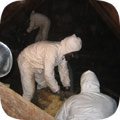 |
|
| I visited my friend Matt in Massachusetts, and he brought me to one of his attic cleanout jobs. This attic was filled with bat droppings, or guano, due to an infestation of Big Brown Bats. It's important to remove the droppings, because they not only smell bad, but can grow mold over time, mold that can cause lung diseases for the inhabitants of the house. The insulation in the attic was also sub-par, so Matt decided to remove all of the droppings and insulation, clean the attic, and add new insulation. I helped out on the day that we removed the droppings and insulation. ...click for more |
10.24.2003 - How To Vacuum the Attic to Get Rid of Animal Waste
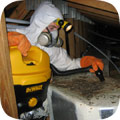 |
|
| This attic was infested with rats. They left thousands of droppings throughout the attic. The homeowner wanted his attic cleaned, but did not want to pay for complete insulation replacement. Thus, I cleaned the attic manually. It involved several steps. The first is to physically remove as many of the rat droppings as possible. This attic had rolled-out BAT insulation, which is easy to vacuum, unlike the blown-in loose fill insulation. In the above photo, we see that I'm vacuuming rat droppings off a duct and into a small portable vaccum. This type of vacumm is good for use in a...click for more |
01.08.2005 - Animal Poop in the Attic - Diseases from Wildlife Waste
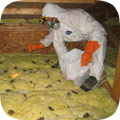 |
|
| If you've had wild critters living in your attic, it's a good idea to have the attic cleaned. Wild animals leave their waste behind when they inhabit an attic. This waste can carry a number of zoonotic diseases. There are at least 42 important diseases that people get by ingesting or handling food or water contaminated with animal feces, such as Campylobacter infection, which us found in animal feces, and causes gastrointestinal symptoms. There's also Leptospira infection. Humans get infected via contact of insulation containing urine from infected animals. Left unt...click for more |
7.18.2006 - Attic Cleanup - Remove Wildlife Waste & Poop
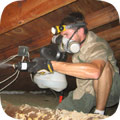 |
|
| In the above photo I'm spraying the attic with my atomizer to destroy the animal waste. I usually wear a biohazard suit, but this attic was about 150 degrees in the Orlando July, so I skipped it. Not a good idea, but I showered immediately afterward, and I always wear my HEPA filter mask. This attic had rats, and the brown chipped insulation, which meant that I couldn't see all the droppings very well, nor vacuum them. This fogging machine, also called an atomizer, sprays my cleaning solution in a fine mist that permeates the entire attic, and makes certain attic cle ...click for more |
4.14.2004 - Attic Restoration - Fix and Clean the Attic
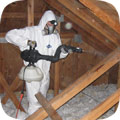 |
|
| Attic restoration is the term often used in the nuisance wildlife control industry to describe the process of restoring an attic to its original state after it has been inhabited and soiled by wildlife. So for example, in this case, a family of squirrels lived in this attic for years, and created a big mess within, by bringing in a great deal of nesting material, and also leaving behind a lot of waste - both droppings and urine, which I could easily smell. The problem with the nesting material is that it creates a potential fire hazard. It's all flammable plant material, and of course it's ...click for more |
06.16.2005 - Attic Decontamination - Clean and Deodorize the Attic
 |
|
| This is a standard attic decontamination job. This attic was infested with rodents - both Roof Rats and Eastern Gray Squirrels. I trapped and removed all of the animals and indentified and permanently sealed shut all of the entry points. However, the attic remained vulnerable, because the rodents had left behind their scent, and the entire border of the house was vulnerable. The rats and squirrels had chewed their way into the wooden fascia board and right down into gaps in the wooden roof that lay below barrel tiles. It's important to remember that rodents communicate via t...click for more |
01.01.2006 - Fix Holes in Roof to Keep Out Animals
 |
|
| This house was located in a very fancy neighborhood in Orlando, right behind a gleaming white Mormon temple and surrounded by other beautiful houses. But
the inside of this house was not so beautiful and gleaming. It was filled with rats and squirrels, and all the droppings, urine, nesting material, parasites, and odor that come
with a rodent infestation. I was called in to take care of the situation. The homeowner heard a lot of scratching and running and scampering around, both day and
night. When I arrived at the home, I took one glance at it, and I ...click for more |
01.01.2006 - Animal on the Roof - Trap and Remove
 |
|
| This was yet another case of an animal in an attic. The customer called me, and was hearing all sorts of running and walking noises in the attic, with
most of the activity coming at night. From the description of the problem, it sounded like a larger animal, as opposed to rats or squirrels. Larger animals most
commonly include raccoons and opossums. I arrived at the house and began my inspection. It wasn't hard to find that a large hole had been torn right into the roof.
At this point, I knew that I was dealing with a raccoon. Only raccoons are strong enough to claw and ...click for more |
01.01.2006 - Animals Gnaw on Electrical Wires
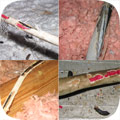 |
|
| One of the greatest dangers of having wild animals living in your attic is that they can cause destruction, in particular, to electrical wires. Many
animals like to gnaw and chew, but most cases of wire destruction are from rodent species - squirrels and rats. I have been in thousands of attics so far in my career as
a wildlife removal specialist, and a good percentage (more than not) of the houses with rodent infestations have some extent of chewing on the electrical wires. The four
photos above represent just a few of the cases I've seen so far. A rodent is ...click for more |
01.01.2006 - Raccoon Holes Leading Into Attic
 |
|
| Here are a couple of classic raccoon entry points. This house has wooden soffits. Oftentimes, homes such as these have vent holes in the soffits.
These vent holes are a standard size and shape, about a food long by four inches wide, with round ends. This hole may not look very large, but animals can squeeze through
very small areas. While it's easy to imagine a rat or squirrel running through these types of holes - and they do - a full sized raccoon can also easily slide through
these openings. Yes, a big fat raccoon. In the above photos you can see a lot of muddy foot ...click for more |
01.01.2006 - Animals Under the House - Keep them Out
 |
|
| This is an older house in Orlando, built in the 1940's. Like many Florida homes, it is elevated off the ground to prevent water damage. It of course
has no basement. Most such homes have solid walls leading to the ground. They have vents, for airflow, but at least they have walls. Not this home. It
was simply an elevated home with no walls, and just a wide-open space leading under the home. It's no surprise then, that over the years this house has been a favorite
home to wild animals! Critters just love to live in a dry place, and an open home like this is ...click for more |
01.01.2006 - Squirrel Hole Fix
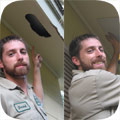 |
|
| Here I am, doing my job as a nuisance wildlife control operator, up on a stepladder, bolting in a new vent cover to keep wildlife out. It's about more
than just catching critters. In my opinion, the more important step is in preventing them from causing problems in the first place. This home had squirrels in the
attic. They were able to enter the house via these vent holes in the soffit. The flimsy vent covers have rotted and fallen out over the years, and it's a very
simple access point for squirrels and other animals. Squirrels can climb concrete walls like this, or just go ...click for more |
01.01.2006 - Ladder Work on Apartments
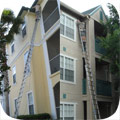 |
|
| Most of my jobs involve ladder work. Except for cases of ground trapping, most cases of wildlife removal involve animals that have invaded homes or
buildings, usually the attics, and I need to address the problems high up, where the animals get in. This calls for ladder work. I carry three standard ladders on
my truck. One is just a 6' stepladder, which I mostly use to enter ceiling attic hatches inside homes. I also use it for work repairing under eaves of single story
homes, and other home repairs for which I only need a few extra feet of height. The second ladder is ...click for more |
06.30.2005 - Mess Under House
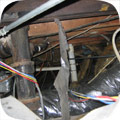 |
|
| My job as a wildlife removal specialist requires that I go where the animals go - in order to trap them, to find out how they are entering a house and repair
those holes, and to remove dead animals where they lie. Oftentimes, I work underneath homes. Here in Florida, many buildings are elevated due to the high water
table and the chance for flooding and water damage. Thus, many buildings have crawl spaces underneath, and these areas are very attractive to wandering critters in search
of a home. I often set traps underneath homes. I often perform repairs on ...click for more |
01.01.2006 - Fix Hole to Keep Rats Out of House
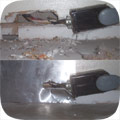 |
|
| Here's probably the most common place that rats use to get from the attic into the living space - the power supply for the kitchen stove. It's by far the
most common area of entry. The reason for this is because the power lines run up through the wall, and the rats in the attic will run along that power line as an easy
thing to descend and climb. A hole is always cut in the drywall to allow the cord to go through, and rats use that hole. If the hole isn't large enough, but rats
can smell that tasty kitchen air coming through the hole, they just chew a larger hole to get in. I was ...click for more |
01.01.2006 - Soffit Repair To Keep Critters Out of Attic
 |
|
| One of the most common areas that animals use to enter an attic is the soffit. The soffit is technically the bottom of the eave. Most homes have
aluminum or vinyl soffits, in track form, held in by J-channels affixed to the eave and the wall. Some homes have wooden soffits. Most soffits have some form of
ventilation - holes in the aluminum, or separate vents in the wood, or even a ventilation strip running the length of the soffit, with a screen. Most soffits are
vulnerable to animal entry, and given the architecture of a house, the eave leads right into the attic, where ani ...click for more |
07.18.2005 - Barrel Tile Roof - Allows Rodents In Attic
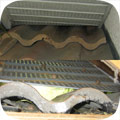 |
|
| Here is a photo demonstration of one of the classic problems with barrel tile roofs, and the reason homes with such roofs have such a high rate of wildlife
problems. Barrel tile roofs lead wide-open holes into the attic! I have taken two photos of the same area - one as seen from outside, and one of the same area,
taken from inside the attic. You can see that this house has a barrel tile roof - these curvy Spanish-style tiles are very popular in Florida. And of course the
house has soffits, the bottom of which are flat. With a flat roof, the soffit lies flat. With a barrel tile roof ...click for more |
05.02.2006 - Tile Roof Repair - Roof Rat Prevention
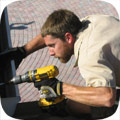 |
|
| This was a difficult job. It was a large house with a roof rat problem. The only way to permanently get rid of rats is to seal off all of their entry
holes. This is one of the most difficult types of homes in which to solve the rat problem, because it has a barrel tile roof, and not just that, a barrel tile roof with an open
perimeter. That means that around the edge of the roof are open gaps under every last tile. Rats can enter these wide-open areas at will, and run underneath the
"tunnel" under the tiles and find any opening into the attic, such as where plumbing stacks go through the ...click for more |
01.01.2006 - Vent Repair to Keep Squirrels Out
 |
|
| Attic vents are a common wildlife entry point, particularly for squirrels and rats. The above photos were taken at two different homes, one of which had a
squirrel problem, and one of which had a rat problem. The rodents were entering the attic through improperly screened vents. You can see in the photo on the right
that this vent used to have a screen of some kind, but it was very flimsy, and it eroded with time. Rats were able to easily climb right into the attic. I sealed off the
vents with a heavy-duty steel screen. In the photo on the right, squirrels were seen ...click for more |
|


